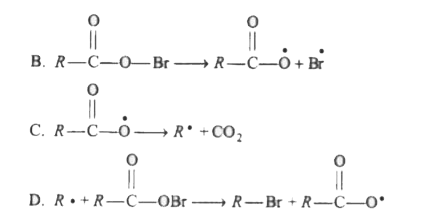Polymerisation of butadiene by free radical mechanism gives:
trans-1,4-polybutadiene
cis-1,4-polybutadiene
polyvinyl polyethene
polyallyl polyethene
The correct Answer is:A, B, C
To solve the question regarding the polymerization of buta-1,3-diene by free radical mechanism, we can follow these steps:
Step 1: Understanding the Structure of Buta-1,3-diene
Buta-1,3-diene has the following structure:
H2C=CH−CH=CH2
This structure consists of four carbon atoms with two double bonds between them.
Step 2: Identifying the Polymerization Mechanism
The polymerization of buta-1,3-diene can occur through a free radical mechanism. This involves the formation of free radicals that initiate the polymerization process.
Step 3: Considering the Reaction Conditions
The polymerization typically occurs under high temperature and pressure conditions, which facilitate the breaking of double bonds and the formation of new single bonds.
Step 4: Identifying Possible Polymerization Centers
The polymerization can occur at different carbon centers:
- C1 and C2: This leads to the formation of polyvinyl polythene.
- C1 and C4: This can lead to two different forms based on the arrangement of the polymer:
- Cis-1,4-polybutadiene: When the polymerization occurs with a cis configuration.
- Trans-1,4-polybutadiene: When the polymerization occurs with a trans configuration.
Step 5: Naming the Resulting Polymers
Based on the centers chosen for polymerization, the resulting polymers are:
- From C1 and C2: Polyvinyl polythene
- From C1 and C4 (cis): Cis-1,4-polybutadiene
- From C1 and C4 (trans): Trans-1,4-polybutadiene
Step 6: Conclusion
The correct answers to the question about the polymerization of buta-1,3-diene by free radical mechanism are:
- Polyvinyl polythene
- Cis-1,4-polybutadiene
- Trans-1,4-polybutadiene
Final Answer
The polymerization of buta-1,3-diene by free radical mechanism gives:
1. Polyvinyl polythene
2. Cis-1,4-polybutadiene
3. Trans-1,4-polybutadiene
---
Buta-1,3-diene has the following structure:
H2C=CH−CH=CH2
This structure consists of four carbon atoms with two double bonds between them.
The polymerization of buta-1,3-diene can occur through a free radical mechanism. This involves the formation of free radicals that initiate the polymerization process.
The polymerization typically occurs under high temperature and pressure conditions, which facilitate the breaking of double bonds and the formation of new single bonds.
The polymerization can occur at different carbon centers:
- C1 and C2: This leads to the formation of polyvinyl polythene.
- C1 and C4: This can lead to two different forms based on the arrangement of the polymer:
- Cis-1,4-polybutadiene: When the polymerization occurs with a cis configuration.
- Trans-1,4-polybutadiene: When the polymerization occurs with a trans configuration.
Based on the centers chosen for polymerization, the resulting polymers are:
- From C1 and C2: Polyvinyl polythene
- From C1 and C4 (cis): Cis-1,4-polybutadiene
- From C1 and C4 (trans): Trans-1,4-polybutadiene
The correct answers to the question about the polymerization of buta-1,3-diene by free radical mechanism are:
- Polyvinyl polythene
- Cis-1,4-polybutadiene
- Trans-1,4-polybutadiene
The polymerization of buta-1,3-diene by free radical mechanism gives:
1. Polyvinyl polythene
2. Cis-1,4-polybutadiene
3. Trans-1,4-polybutadiene
Topper's Solved these Questions
- SYNTHETIC AND NATURAL POLYMERSBook:CENGAGE CHEMISTRY ENGLISHChapter:SYNTHETIC AND NATURAL POLYMERSExercise:Exercises Single Correct
Explore 94 Videos
- SYNTHETIC AND NATURAL POLYMERSBook:CENGAGE CHEMISTRY ENGLISHChapter:SYNTHETIC AND NATURAL POLYMERSExercise:Exercises Assertion Reasoning
Explore 10 Videos
- SYNTHETIC AND NATURAL POLYMERSBook:CENGAGE CHEMISTRY ENGLISHChapter:SYNTHETIC AND NATURAL POLYMERSExercise:Exercises Linked Comprehension
Explore 30 Videos
- SURFACE CHEMISTRYBook:CENGAGE CHEMISTRY ENGLISHChapter:SURFACE CHEMISTRYExercise:Archives Subjective
Explore 2 Videos
Similar Questions
Knowledge Check
Free radicals can undergo
Arearrangement to a more stable free radicalBdecomposition to give another free radicalCcombination with other free radicalDall are correctThe Hunsdiecker reaction is believed to proceed by a free radical mechanism and involves the formation of an acyl hypohalite.


The major product is :APh−CH=CH−−∣CH3BrBPh−Br∣CH−CH=CH−CH3CPh−CH=Br∣C−CH2−CH3DP−CH=CH−C∣CH3H−CH2BrThe Hunsdiecker reaction is believed to proceed by a free radical mechanism and involves the formation of an acyl hypohalite.


 A
A B
B C
C D
D
The free radical which is most stable is
View SolutionIn iso-pentane, the H atom that can be most easily substituated by free radical mechanism is on:-
1CH3−2C∣CH3H−3CH24CH3
View Solution
In which amongs the following product is formed by free radical mechanism ?
View SolutionThe Hunsdiecker reaction is believed to proceed by a free radical mechanism and involves the formation of an acyl hypohalite.


The rate determining step is :
View SolutionThe most stable free radical is
View Solution